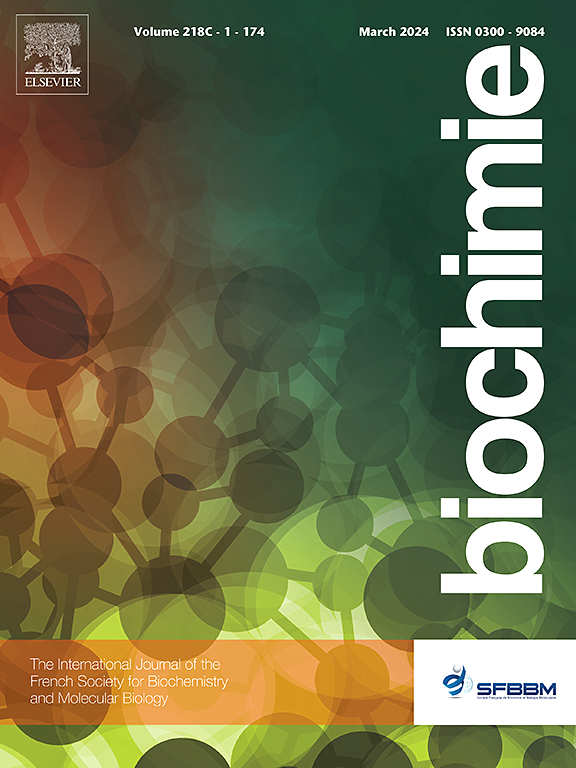Developmental overlap between skeletal muscle maturation and perirenal fat brown-to-white transition in goats: Exploring the role of Myf-5
IF 3.3
3区 生物学
Q2 BIOCHEMISTRY & MOLECULAR BIOLOGY
引用次数: 0
Abstract
In mammals, skeletal muscles (SkMs) and adipose tissues regulate energy homeostasis and share developmental origins. Notably, the perirenal adipose tissue (PRAT) depot has been reported to display adipocyte heterogeneity: while some originated from Myogenic factor 5 (Myf-5) expressing progenitors, others did not. Our study examines the expression and distribution of Myf-5 using immunohistochemical staining and western blotting of PRAT, gastrocnemius, and trapezius from goat at various developmental stages. Contrary to earlier beliefs, functionally divergent SkM gastrocnemius and trapezius showed similar Myf-5 expressional pattern. SkM abundantly expresses Myf-5 in developing myocytes which gradually becomes limited to the nucleus of myogenic stem cells and is retained only in a few differentiated postnatal fibers. During the same period, PRAT displays a unique brown-to-white transition. PRAT exhibited an elevated expression of Myf-5 during prenatal periods, which declines thereafter and becomes negligible during adulthood where it gets fully enriched white adipocytes. The reduction of Myf-5 during the neonatal period was common to all three tissues. However, Myf-5 expression was retained in some of the differentiated myofibers while it was undetectable in adult PRAT. These observations suggest a possible developmental interplay between adipose tissue and SkM where Myf-5 might be a major regulator.
山羊骨骼肌成熟与肾周脂肪褐色到白色转变之间的发育重叠:探索 Myf-5 的作用。
在哺乳动物中,骨骼肌(SkMs)和脂肪组织调节能量平衡,并且具有共同的发育起源。值得注意的是,有报道称肾周脂肪组织(PRAT)库显示出脂肪细胞的异质性:一些来源于表达肌原因子 5(Myf-5)的祖细胞,而另一些则不是。我们的研究采用免疫组化染色和 Western 印迹法对处于不同发育阶段的山羊 PRAT、腓肠肌和斜方肌进行了研究,探讨了 Myf-5 的表达和分布情况。与之前的观点相反,功能上不同的SkM腓肠肌和斜方肌表现出相似的Myf-5表达模式。SkM在发育中的肌细胞中大量表达Myf-5,而Myf-5逐渐局限于成肌干细胞的细胞核中,仅保留在少数分化后的纤维中。在同一时期,PRAT 表现出独特的棕色到白色的转变。PRAT在产前表现出Myf-5的表达升高,随后下降,到成年期可忽略不计,在成年期Myf-5完全富集到白色脂肪细胞中。新生儿期 Myf-5 的减少是所有三种组织的共同特征。然而,在一些已分化的肌纤维中保留了Myf-5的表达,而在成年PRAT中则检测不到。这些观察结果表明,脂肪组织和SkM之间可能存在发育上的相互作用,其中Myf-5可能是一个主要的调节因子。
本文章由计算机程序翻译,如有差异,请以英文原文为准。
求助全文
约1分钟内获得全文
求助全文
来源期刊

Biochimie
生物-生化与分子生物学
CiteScore
7.20
自引率
2.60%
发文量
219
审稿时长
40 days
期刊介绍:
Biochimie publishes original research articles, short communications, review articles, graphical reviews, mini-reviews, and hypotheses in the broad areas of biology, including biochemistry, enzymology, molecular and cell biology, metabolic regulation, genetics, immunology, microbiology, structural biology, genomics, proteomics, and molecular mechanisms of disease. Biochimie publishes exclusively in English.
Articles are subject to peer review, and must satisfy the requirements of originality, high scientific integrity and general interest to a broad range of readers. Submissions that are judged to be of sound scientific and technical quality but do not fully satisfy the requirements for publication in Biochimie may benefit from a transfer service to a more suitable journal within the same subject area.
 求助内容:
求助内容: 应助结果提醒方式:
应助结果提醒方式:


